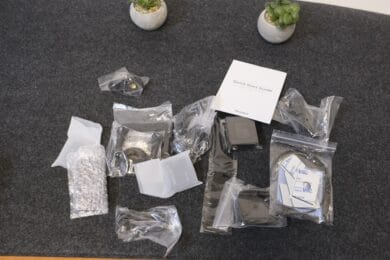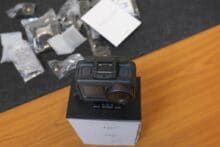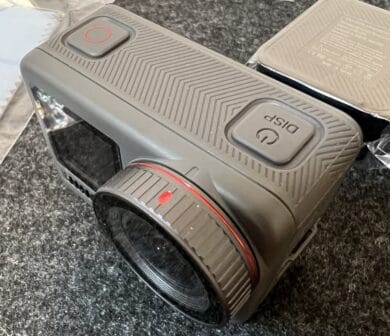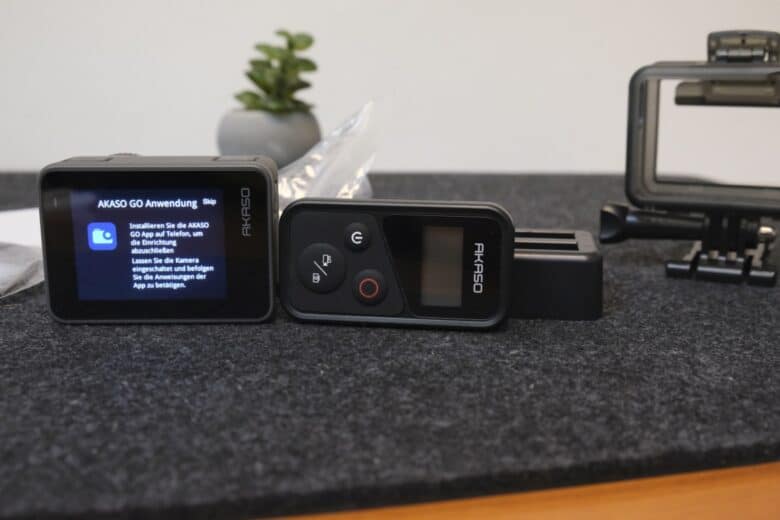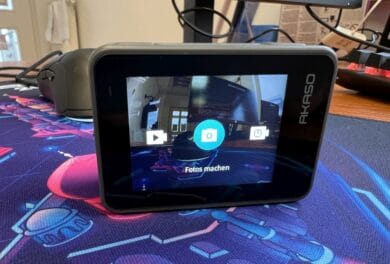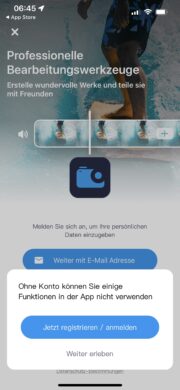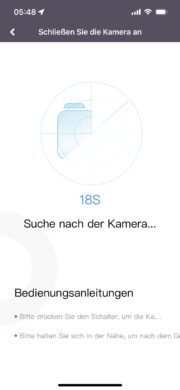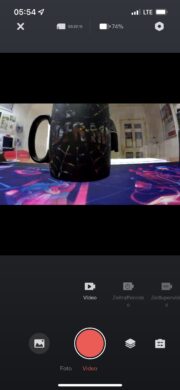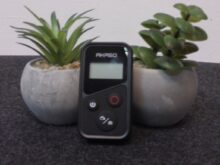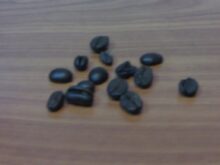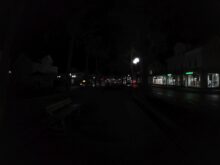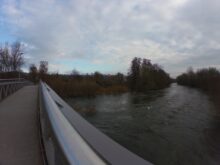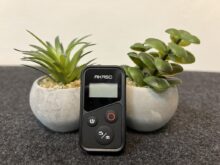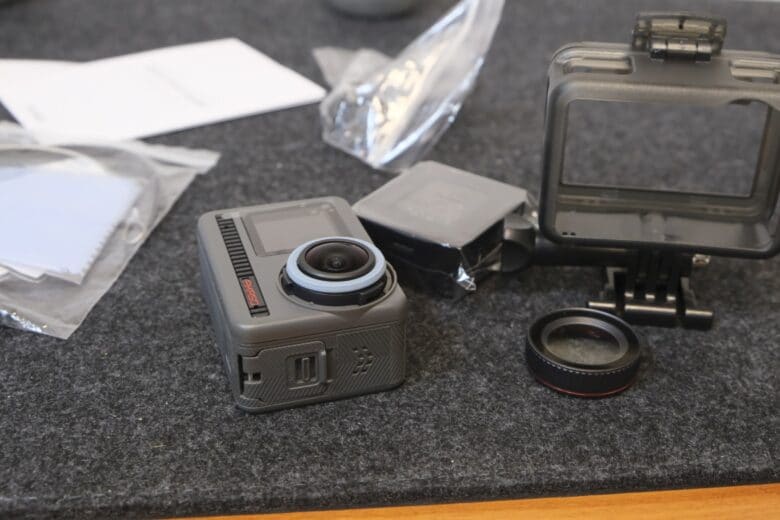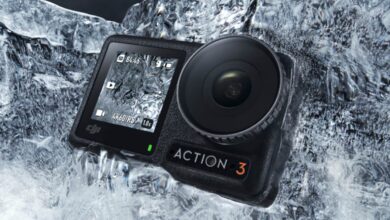
After we took a detailed look at its predecessor in May 2021, the manufacturer’s latest action cam, the Akaso Brave 8, reaches our test lab. It offers twice the frame rate for video recording, while the sensor for photos has a whopping 28 megapixels. Our Akaso Brave 8 review reveals whether the criticisms of the predecessor model could be eliminated.
Technical data
|
Dimensions: |
63 mm x 45 mm x 36.5 mm |
|
Weight: |
Camera & Battery: 115 g |
|
Sensor: |
1/2 inch CMOS |
|
Video modes: |
2160p@60, 2160p@30, 2719p@120, 2719p@90, 1080p@200 |
|
Video format: |
H.264 / H.265 |
|
Photo modes: |
12 megapixel, 48 megapixel |
|
Photo format: |
JPG, JPG+RAW |
|
Features: |
Electronic Image Stabilizer (Six Axis), Voice Control, Second Display, Time Lapse, Slow Motion, Smartphone App, SuperSmooth Stabilization |
|
Display: |
2.0 inch, touchscreen / 1.22 inch display |
|
Battery: |
Lithium-ion, 1,550 mAh, two pieces |
|
Connectivity: |
USB-C , WLAN, microSD slot |
|
Protection standard: |
IPX8 (protection against continuous submersion up to 10 m) |
|
Price: |
Akaso Brave 8 review: scope of delivery
The Akaso Brave 8 comes, just like its predecessor, in a chic black box, which presents the action cam directly in a transparent cover. The scope of delivery was already impressive almost a year ago, and this time the manufacturer also includes an almost unbelievable amount of accessories in the box.
Freeing the action cam from its plastic holder is a feat of strength at first, because it fits tightly. The camera is placed in a protective cover, which provides additional protection against bumps and scratches.
There is also a huge selection of additional components, including seven different mounting options, a steering wheel mount for bikes and the like, helmet mounts, arm and wrist straps, tethers, a microfiber cleaning cloth, a remote control, a USB Type-C to USB Type-A charging cable, the corresponding charging station and even two batteries. Chapeau, this is what a scope of delivery has to look like. No wishes are left unfulfilled here.
Design and workmanship
In terms of basic design, the Akaso Brave 8 shows changes only in nuances. As was the case with the Brave 7, the two-inch touchscreen once again takes up almost the entire back of the action cam, which comes in at an overall size of 63 mm x 45 mm x 36.5 mm, making it minimally flatter but slightly deeper than its predecessor.
A second, 1.22-inch screen is found on the left side of the action cam’s front. To the right is the lens, which consists of a total of nine lenses and a 1/2-inch CMOS sensor.
On the top are two buttons for turning the cam and display on and off, as well as the shutter release and record buttons. The battery cover has moved to the bottom of the camera in the case of the Akaso Brave 8, while the cover for inserting the microSD card, as well as the USB port can still be found on the side. On the right side is the “M” button, which we can use to access the action cam’s menu.
However, we are once again looking in vain for threads, for example for tripods or other connection options. These can only be found in the protective frame of the new edition. The action cam itself is already waterproof up to a depth of 10 meters (IPX8) and protected against dust. In combination with the protective cover, the Brave 8 can also be used when diving, as this increases the water resistance to up to 60 meters.
Processing of the Akaso Brave 8
There is also little to complain about in terms of workmanship in the Akaso Brave 8 test. The action cam leaves a good haptic impression and fits well in the hand with its compact size. Thanks to the ribbed surface, the cam does not slip out of the hand even in outdoor use.
However, we have to criticize the microSD card slot once again, because the manufacturer has not learned anything compared to the predecessor. The memory card still disappears so far into the casing that you can hardly get it out without tweezers or a ballpoint pen. It is also a bit annoying that the covers for the microSD and battery compartment are a bit difficult to open.
Operation, technology and practice
Of course, the Brave 8 is mainly operated with the help of the rear touchscreen, which we use to switch between video and photo modes or to set the resolution as well as frame rate. Holding down the menu button for three seconds switches to the front-mounted screen, which makes selfies noticeably easier. However, the screen does not have any touch functionality and therefore does not react to touches.
The resolution of the front display is also limited. However, the quality is sufficient to put oneself in the right light, but the display is not suitable for more. The touch control of the rear screen works flawlessly.
However, we would have liked to see a bit more functionality in the menu navigation. It is only possible to switch between the shooting modes and zoom into the picture. In addition, it is possible to switch between full resolution and a smaller 12-megapixel image for photos.
The menu reacts comparatively slowly to inputs, while the fine settings for white balance, ISO value and much more can be reached somewhat hidden by swiping upwards from the bottom edge of the screen. However, this is not even explained in the half-page quick start guide, so we only discovered this feature after downloading the full manual from the manufacturer’s homepage. User-friendly this is not.
Brave 8 in practice
Nice, on the other hand, is the voice control. With commands like “Akaso Take Photo”, you instruct the action cam to take a photo. This is quite practical if you do not have a free hand and works quite well in practice. However, it also takes a few seconds until the cam implements our command. Therefore, it is rather unsuitable for a quick snapshot.
We also find the protective cover impractical. It is the only option to attach the Brave 8 with a holder and partially covers the microSD card and USB-C port. Thus, neither the memory card can be removed nor the battery charged when the action cam is in the protective case.
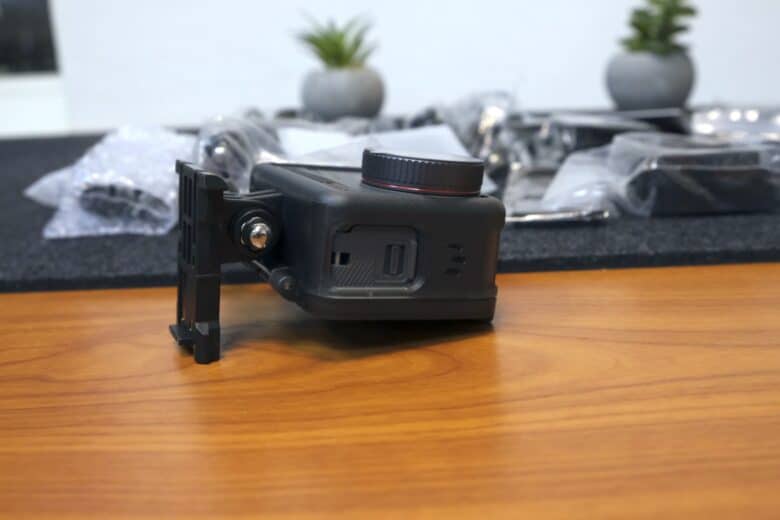
In terms of image and video formats, however, the Brave 8 leaves little to be desired. Videos can be recorded in a maximum of 4K with 60 FPS. In addition, super slo-mo videos with 16x slowdown or time-lapse videos in 8K format are possible. Photos are taken by the action cam with 48 megapixels, which promises detailed photos – but more on that later.
App connectivity: Akaso Go
The companion app Akaso Go, which is free to download on iOS and Android, also causes additional trouble. First of all, this starts with the registration requirement, because if you don’t create an account within the app, you won’t even be able to use it and its theoretically extensive features. The intrusive reward points system, which is unlikely to interest anyone in this country, is also annoying and causes resentment with regular notifications.
Another problem is the cooperation, or rather communication, between the app and the camera. While the Akaso Brave 8 was immediately recognized by the app and a firmware update was suggested when it was first started in our test, it repeatedly turned into a real game of chance whether the app would even find the action cam that was located a few centimeters away. We could not find the exact reason for this, especially since the problem occurs on both iOS and Android.
It is conceivable that it is due to the Wi-Fi connection, since the app needs an active Internet connection, but it has to connect to the cam via an internal Wi-Fi connection instead of via Bluetooth or similar.
If communication does work out, it noticeably expands the camera’s functionality and allows for convenient fine-tuning of the image or streaming directly from the inserted microSD card.
Note: On 02/15/2022, the manufacturer released an update to the Akaso Go app for iOS and Android that partially improved the reliability of the connection. However, a large part of the bugs and connection problems remained.
Image quality of the Akaso Brave 8
After all the hassle about the app, let’s take a look at the image quality of the Akaso Brave 8, which is much better compared to its predecessor, at least on paper. Basically, the same applies here as in the case of the Brave 7, because the action cam delivers a really convincing picture quality in very good lighting conditions.
In a direct comparison with the GoPro HERO10 Black, however, the Akaso Brave 8, which is still around 200 Euros cheaper, loses out in all aspects, and quite clearly at that. Sharpness, colors, level of detail and stabilization cannot keep up with the competitor, and even the GoPro HERO8, which is now similarly priced, delivers better results here.
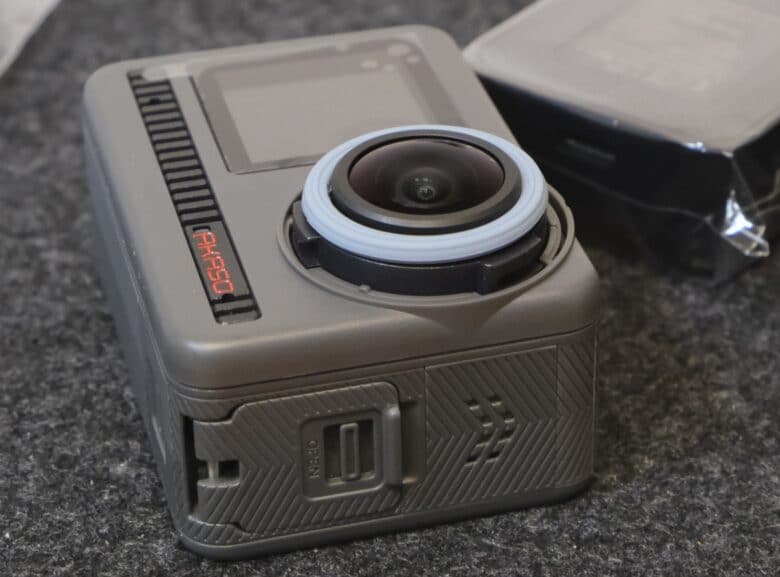
Photo quality
Given the 48-megapixel sensor, the quality of the still images is absolutely fine and provides significantly more detail than in the case of the Brave 7. In very good lighting conditions, the images are quite convincing in outdoor use.
However, compared with a current smartphone camera or a real lens, the photos from the action cam lack contrast, sharpness and colors. The photo quality is thus sufficient for one or two quick snapshots, but not more.
In the following, we will show you a comparison of the image quality between the Brave 8 and the iPhone 13 Pro. All pictures are taken directly from the action cam or the smartphone without any processing.
Akaso Brave 8
iPhone 13 Pro
Video quality
But to be fair, an action cam is meant for videos. Accordingly, we were particularly curious about this area during the Akaso Brave 8 review. What is initially noticeable is that the colors look washed out in normal mode and lack a certain brilliance – especially compared to the GoPro competition. Switching to the “Vivid” color mode noticeably remedies this.
In direct comparison to the Brave 7, however, things have changed. Videos recorded with the Brave 8 have a warmer color scheme and convince with better contrasts and a significantly higher level of detail. However, this once again applies to good lighting conditions, because the current model has to deal with the same problems as its predecessor in the low-light range – especially the strong image noise disturbs the overall picture.
If the lighting conditions are right, however, the Brave 8 delivers a really good video result. Especially the image stabilization could convince us again in the test. Two modes are available here: “Normal” and “SuperSmooth”.

However, only normal stabilization is done directly in the camera. In SuperSmooth, stabilization is done within the Akaso Go app, which has to be running reliably for this to work.
Good image stabilization, weak microphone
However, the normal image stabilization is already convincing and does not have to hide behind the top dogs in the action cam sector. In terms of colors, ambient details and general sharpness, however, the Akaso Brave 8 is sometimes clearly behind the competition, which is also available at a higher price.
Especially when shooting in the early morning or in the evening, when many contrasts come into play, the action cam weakens and lets many surrounding details degenerate into a picture mud. In detail, it is also noticeable that the image sharpness is only completely convincing in the center, but decreases considerably towards the edges.
Once again, the built-in microphone is barely usable. Both in terms of volume and sound quality, we only achieved average results that are hardly usable in practice. Thus, you should definitely fall back on an external microphone.
Battery life of the Akaso Brave 8
In terms of battery capacity, the Brave 8 makes significant gains. 1,550 mAh are supplied by the two cells that the manufacturer includes in the package. The predecessor still had 1,350 mAh. However, the battery runtime has not improved much. We still get around 90 minutes of 4K recordings in H265 format and Full HD videos with 60 FPS. We still get around 130 minutes with timelapse videos.
Unfortunately, the battery status indicator doesn’t really work reliably. During our test, the status sometimes jumped down by several percent and was far above the previously displayed value after the camera was turned on again. It is unclear whether this is a software bug.
Conclusion on the Akaso Brave 8
Is the Brave 8 better than its predecessor? Yes! Is it a recommendable action cam, considering the price? Unfortunately, I have to answer this question with a resounding “no”. Considering the price of around 300 euros, the Akaso simply offers far too little.
The build and design are still on a really good level and the scope of delivery is gigantic. However, the cam is clearly weaker in all other areas and constantly lags behind the competition, some of which is several years old.
The handling is not very intuitive and the high latency is annoying. At the same time, the companion app is an imposition with its compulsory registration and connectivity problems, as well as several bugs (even with the latest firmware).
The video quality, which is really good in the 4K range and in good lighting conditions, should be highlighted positively. Especially in Vivid color mode and with image stabilization enabled, videos in 4K with 30 FPS are convincing. However, the competition from GoPro delivers better results here as well. Photos from the Akaso Brave 8, on the other hand, are not usable at all.
Akaso Brave 8
Workmanship
Hardware
Photo quality
Video quality
Software and features
Value for money
78/100
Well-made and chic action cam that convinces in terms of image quality in good lighting conditions. However, it offers far too little for the high price.
